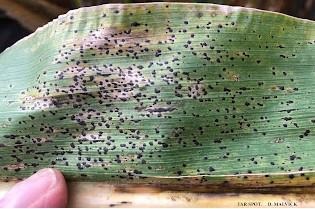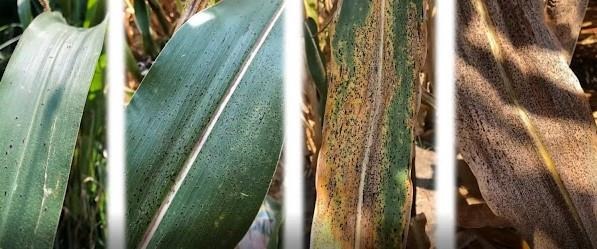By Phyllis Bongard
As we move into early August, the high variability in weather conditions and crop growth stages has affected the risk for significant crop disease. Dean Malvick, Extension plant pathologist, joined moderators Angie Peltier and Ryan Miller, Extension educators, for the August 3rd Field Notes session to discuss the concerns.

Observations from around the state
Southeastern Minnesota
To date, there have not been any incidents of tar spot or other corn leaf diseases in either the sentinel tar spot hybrid trials or general scouting reports.
More concerning in this part of the state is the level of field spraying activity for soybean aphid. Miller’s team has been monitoring soybean aphid for several weeks and have not found any significant infestations. The bottom line for growers is to scout for soybean aphid to make sure applications are cost effective while reducing the risk of developing insecticide resistance.
Northwestern Minnesota
Soybeans are beginning to pull out of iron deficiency chlorosis (IDC) and are close to closing rows in this part of the state. Besides IDC, there are limited reports of bacterial blight. In general, the soybeans are looking clean.
Corn is also looking good. However, areas that got hail and high winds might expect to see some patches of Goss’s wilt start to show up.
Southwestern and south-central Minnesota
There have been a few reports of significant Phytopthora issues in soybeans. We usually don’t see many large outbreaks of this disease, but high soil moisture in some areas has increased the risk. Rhizoctonia has also been reported in some locations.
Other diseases have been noted, but not at any levels of concern: Bacterial blight and Septoria brown spot.
There are not a lot of major issues in corn reported, either, but this is the time of year when corn diseases start to take off.
Tar spot
Tar spot is a relatively new fungal corn disease that can develop and escalate quickly. Tar spot was discovered in 2015 for the first time in the U.S. in northern Illinois and northern Indiana. Since then, it has spread across much of the corn belt, from Wisconsin and Michigan to southern Illinois and as far east as Pennsylvania. In some states, tar spot has caused yield losses of 40 to 50 bushels, although that level of loss has not been seen in Minnesota.
In Minnesota, it was first found in Fillmore County in the southeastern part of the state in 2019. Since then, it’s been confirmed as far north as Stearns County, so it can spread rapidly.
What to look for
Tar spot gets its name from the small, black, raised fungal structures that are produced on the leaves. At this time of the year, they’re often hard to find, because the initial spots can be mistaken for insect frass or dirt. Unlike frass or dirt, tar spot lesions cannot be easily wiped from the leaf. It can also be difficult to find if it develops in patches in the middle of the field. Scouting requires ‘eagle eyes’ at this early stage.
Catching this disease early is important, though, because it can progress from scattered black spots on the leaves to leaves being completely covered and killed in 2 to 3 weeks under the right weather conditions.
 |
| Tar spot can progress from scattered lesions to killed leaves in 2 to 3 weeks. Photos: Dean Malvick, UMN |
How tar spot develops
In most cases, the inoculum is probably coming from residue from previously infected crops within the fields, especially in early season infections. However, spores can also originate from locations outside the field. Malvick explained that it can spread by wind, but we don’t have a good understanding of just how far spores travel on wind currents.
Under the right conditions, spores infect the leaves and symptoms appear in 14-21 days. If moderate temperatures and ample moisture continues, these tar spot lesions can release more spores and the disease keeps cycling in the field.
There is still a lot to learn about risk factors, but these conditions favor tar spot:
- Tar spot was present in field or area last year
- Late planting
- Moderate temperatures (60-70°F)
- Moisture
- Heavy dews and frequent rainfall
- Leaf wetness
- High relative humidity
- Corn on corn
Managing tar spot
Scouting
Scouting is an important management tool. Start looking for tar spot in early July to document where the disease is developing and to identify if potential fungicide applications are needed. The earlier tar spot develops, the higher the risk for damaging levels, depending on favorable weather conditions.
Hybrid selection
Avoid the most susceptible hybrids. More seed companies are identifying hybrids that are less susceptible to tar spot and that can make a significant difference in disease outcomes.
Fungicides
Fungicides can be effective, but application timing is important. While multi-state research has identified the best timings to be between VT (tasseling) to R2 (blister), the applications need to be made near the onset of symptoms to be most effective.
Applications aren’t recommended unless disease is developing in the field and weather conditions look favorable. Insurance applications at VT may lose their protective power before the disease even ramps up. Unless there’s reason to think that an application is needed at VT, it might be wise to wait until R1 or R2.
See Fungicide efficacy for control of corn diseases from the Crop Protection Network for tar spot treatment options.
Irrigation
Finally, manage irrigation to keep leaf wetness at a minimum to reduce the risk of developing disease.
What about the Tarspotter app?
University of Wisconsin has developed a tar spot disease forecaster app. Its model uses a network of local weather stations and the crop’s stage of development to assess tar spot risk. Because we’re still learning a lot about tar spot, some of the variables may be subject to change. For example, an important driver of risk is tar spot history. If there is no clear history of tar spot in a particular field or nearby area, the risk would not be high early in the season. In contrast, if a field is in an area where tar spot has been prevalent in previous years, the risk would be higher.
Tar spot is driven by the weather. While the app uses a network of weather stations, in many cases the nearest station may not be close to the field in question. Since conditions can be highly variable at the landscape level, it’s important for each individual to interpret the app results carefully.
Source : umn.edu